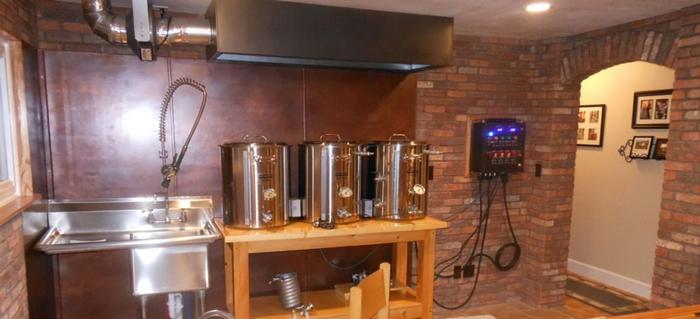Tips on Setting a Brewhouse at Home
Having a glass of ice-cold beer on a hot summer day or after an abundant meal is an absolute pleasure. It refreshes and relaxes, and its slightly bitter taste awakens the senses. Given the many health benefits that regular drinking of this beverage brings, it is no wonder why so many people love it.

You can read more about these health benefits here.
Commercial beers are good, and some are even top quality. But true connoisseurs will tell you that none of them can be compared to craft beer. Smaller production has more chances for a quality end product. And if you make this beverage for your own needs, the addition of love and dedication will make it even better.
There are many benefits to making beer at home, including the ability to customize it to your taste and preferences. Using specialty grains for brewing is easy and can help you experiment with different flavors. As you dedicate yourself to using quality and proven ingredients, it may even be healthier than commercially prepared beverages.
Homebrewing is an entertaining hobby for gathering with other beer lovers. But it doesn’t have to be just a fun way to use your free time. Making craft beer can become a profitable business venture, depending on your dedication and will to commercialize your brewhouse.
Set a Budget
The cost of starting a brewery will depend on the type of operation, the brewery location, and your ambition. Some people start their home brewing efforts with a simple homebrew kit, while others use an industrial-grade system. The best equipment for home brewing is electric, as it can run safely indoors.
Approximately, your investments may range anywhere from $5,000 to $100,000. If you plan to go serious with home brewing, you must pay more for reputable brands’ equipment. You won’t get just the necessary appliances but also technical support for your brewery. Next, you have to equip your premises, find quality ingredients, and always have enough money for unexpected costs.
Know Brewing Basics
Many say that the most significant advantages of homebrewing are the quality and taste of the beverage you brew. Since these are smaller quantities, more attention is paid to the quality of the final product. More or less, it will be on a par with industrial drinks. That’s not a bad thing when you’re a beginner.
Suppose you upgrade your knowledge of beermaking techniques and supplies and dare to combine different ingredients. In that case, the quality of your craft beer will improve over time. Likewise, the more you dedicate yourself to homebrewing, the better the result will be. You might want to check out this link, to find out why craft beer is better than commercial one,
Have Enough Space
After you’ve determined the beer style you plan to make, it’s time to decide the location. You’ll need a room with power, a sink, and ample space to store all your equipment. A garage is often the best option for home brewing, as it allows for a large storage. A basement or attic may not have enough space to accommodate a full-scale brew. Plus, they usually have problems with moisture and poor airflow.
Besides necessary equipment, you can customize your brewing room with unique designs and some comfy furniture. That will make you feel good while working on your craft beer. Sure, the main objective of your home brewery is to make this beverage. Still, it’s important to make it appealing and cozy.
Room Conditions

One of the first steps in building a brewery is sanitizing the space. You can use oxygen-based cleaners that leave no residue and can be used without rinsing. Besides deep cleaning, you should disinfect the room, equipment, and vessels before and after each brewing session. So, ensure that this room has a sanitary station (sink, space for drying, and, if possible, waste disposal under the sink).
Your home brewery should have a constant temperature and airflow. If your garage is tapped to a home HVAC system, great. But if it’s not, or you don’t want to have it connected with the rest of the house, there are various ways to optimize the room conditions.
Since the space is not too ample, you can get a mini-split AC. It allows you to heat and cool the brewery as you wish. Sudsy temperatures can mess up your beer, so make sure you have an even room temperature. Also, the room should be well insulated and vented.
Brewing Equipment
You should follow some key points when choosing brewery equipment. Brewing kits contain all the elements you need to make a beer, like yeast, malt extract, and hop oils. You just have to mix malt with water in the stated ratio and volume, add the yeast, leave everything in a fermenting bucket, and let the magic happen.
Once you have a brew kit, you’ll need a mash tun. It’s the critical part of the brewing process as it mixes malt and water at a controlled temperature. Once you have a mash tun, you’ll need to purchase a brewing tank (carboy). After all, you’ll need a keg rack to keep barrels.
You can start brewing with brewing kits, but these are not sustainable solutions if you plan to develop a craft beer business. Many home brewers upgrade their equipment as the need arises. The brewing process can be complex, so you need easy-to-operate equipment.
For home use, you can check ABS Commercial brewing systems, fermenters, and tanks. Also, you’ll need a mill, thermometer, fermenting vessels, refractometer, an induction burner, and a few more gadgets for a smoother beermaking process. Take good care of these devices and clean them regularly.
Quality Brewing Supplies
Beer is a simple product made of only four things – water, malt extract, hops, and yeast. If you don’t trust commercial malt extracts, you can make your own. In that case, you’ll need quality grains and some patience. Brewing with grain requires a few additional steps and equipment, but the result is usually well worth the effort. You can even grow hops and culture yeast to make organic beer.
Except for water, all mentioned supplies require regular replenishment and proper storage. Finding a good supplier is not easy, but you will be on the right track with a little research. Go online and browse different forums, blogs, and specialized websites. Pay attention to reviews and customers’ comments.
Aside from purchasing quality brewing supplies, you need to ensure they are well-stored and secure. You’ll need to buy shelves, cabinets, and racks to keep your brewing supplies and pots. If you can, have a separate storage area for supplies. It should be dry, cool, and dark.
Enjoy Making Beer

Once you have arranged and equipped the space and procured the necessary ingredients, you can start making beer. You will make mistakes initially, but don’t give up. In time, you will find the right measure and ratio of ingredients. You will also learn how to improve and speed up the process itself, involving additional investment if you’re willing to commercialize your craft beer.
The best way to get a beer that meets your expectations is to research and follow directions carefully. You should start small and enjoy every step of the brewing process. Then, learn along the way and find methods to improve your craft beer.
On Popularmechanics, you can find some basic guidelines on brewing at home.
Making homemade beer brings with it pleasure but also savings and the opportunity for extra income. But keep in mind that making beer also means a lot of responsible work. So if you love this beverage, enjoy the process, and want what you love to bring in extra income, setting up a brewhouse is the right move for you.









